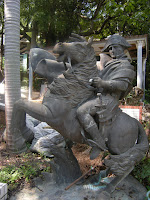[czytaj tego posta po polsku]
September 14th 2010 - I made a motorbike trip from Hsinchu City to Miaoli County and back. The main destination was Lion Head mountain in Miaoli County, but I visited total of 6 spots during this cruise:
1. Ku Chi Feng Park (Chin. 古奇峰, pinyin: GiQi Feng)
2. Sanfeng Charcoal Kiln (Chin. 三峰炭窯)
3. Fuxing Old Town (Chin. 富興老街)
4. Emei Lake (Chin. 峨嵋湖) in Emei Township
5. Quanhua Temple on the Lion Head Mt(Chin. 獅頭山勸化堂)
6. Beipu Old Town
This is Part 1, in which I will cover first 3 places. All 6 are tagged on the map with the trail log below:
1. Ku Chi Feng Park (Chin. 古奇峰, pinyin: GiQi Feng)
2. Sanfeng Charcoal Kiln (Chin. 三峰炭窯)
3. Fuxing Old Town (Chin. 富興老街)
4. Emei Lake (Chin. 峨嵋湖) in Emei Township
5. Quanhua Temple on the Lion Head Mt(Chin. 獅頭山勸化堂)
6. Beipu Old Town
This is Part 1, in which I will cover first 3 places. All 6 are tagged on the map with the trail log below:
Show Bike Trips: 2010-09-14, Hsinchu - Lion Head Mt on a bigger map
1. Ku Chi Feng Park (Chin. 古奇峰, pinyin: Guqi Feng)
Ku Chi Feng Park is located on the southeast of Hsinchu City. It spreads on the area of 10 hectares. It's also located between two other Hsinchu's famous spots: Eighteen Peaks Mountain and Green Grass Lake. Ku Chi Feng is said to be the only recreational park in Taiwan that is also a place of religious significance. A huge 120 meter statue of Kuan Kung is probably it's most known landmark (the statue was built in 1990).
The Park is beautifully located in Baoshan district - a suburb of Hsinchu City and is one of Hsinchu's Top 8 Cityscapes,and as such, it will be covered in more details in the serie of articles about those 8 spots in Hsinchu City. I only visited one of few sections of the Ku Chi Feng Park today, more will come in a separate article.
INFO: this park can sometimes be found in the internet under 'Gucci Hill/Peak/Gaze/Park' :P
Here are some photos taken during the trip:
 |  |  |
 |  |  |
 |  |
2. Sanfeng Charcoal Kiln (Chin. 三峰炭窯)

The Kiln is located in southern Baoshan Township (suburb of Hsinchu City) in a proximity to Taiwan Acacia trees, aka Formosa Acacia (Lat.: Acacia confusa, Chin: 相思樹), which is a tree that grows pretty fast and with a wood of a good quality, very suitable to produce charcoal. In the past most of homes in the area were running on charcoal, therefore the kiln was indeed a part of local economy. In Taiwan the wood business started around 1926, and a wood from Taiwan Acacia was an important part of it. Although the charcoal can practically be made of any wood, the wood from Taiwan Acacia was recognised for especially good quality as the charcoal produced from it didn't emit smoke. Later, however, from 1981, most homes switched to gas, and therefore the role of the kiln was slowly deacreasing. It was preserved though, as an original and interesting landmark. When I visited the site, it was sealed and it seemed like the production of the charcoal was in progress, there was a fire inside and a smoke comming out. I'm guessing that it is still used for charcoal production on a smaller, maybe local scale.
The kiln was previously called Yong-Xing Charcoal Kiln (Chin.永興炭窯). There are very few kilns like this one in Hsinchu County. It is made of a loess (kind of a clay) and partially embedded into a hill's side to reinforce the construction. After choosing loess material for construction it was first put on the ground and given to cows to step on it for many days until it harden firmly, before it was finally used to build the kiln. The roof is made of grass. One kiln like this can produce 2000 to 3000 kilograms of charcoal at one single production process - depending of the size of wood chops used and the exact size of the kiln itself. By default 60-cm-long wood chops are used. First, the wood is put inside to burn, then, sealed inside still hot for 20 days, before it's all ready to be taken out and used as a charcoal (Source). The spot is really cool to visit on the way to somewhere else, or as a small trip from Hsinchu City. Very nice by a motorbike. It looks interesting, feels traditional and there is a place on the site to have a lunch or make a BBQ. On a sunny day it's convinient to sit on a wooden bench in the shadow from the tree, and eat out surrounded by the smell of wood. Finally it's nice to get back home with a collection with really cool photos next to something that looks like nothing else that can be found in Taiwanese scenery. I hope, that a brief introducton will help t appreciate this spot more than without knowing what it actually is.
Below some photos taken on this site:
 |  |  |
3. Fuxing Old Town (Chin. 富興老街)
Next stop I made just before Emei Lake was Fuxing Old Town. It is very small, and rather humble comparing to the Old Town of Beipu, but there is a really pretty temple there, called Longsheng Temple (Chin. 隆聖宮), which was a reason I made a brief stop there. The temple was harmed by a construction field next to it in 1997 and reconstructed by 1999. Some wooden columns from the original temple are preserved and exposed for visitors next to the entrance. It is a famous temple in Emei Township, founded by Hakka people. Besides the temple the Fuxing Old Town had nothing else worth getting off the motorcycle that day. Below some photos:
 |  |  |
 |  |  |
 |  |
To be continued...








No comments:
Post a Comment